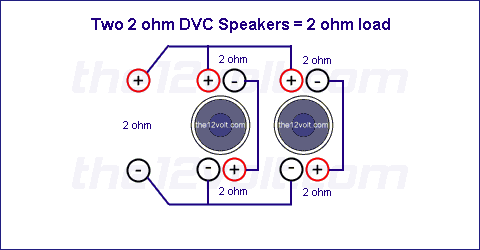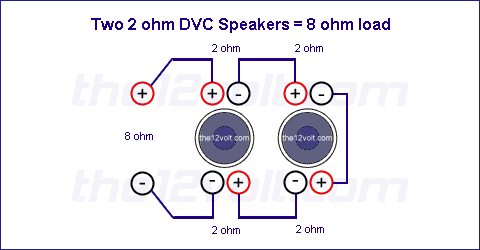someone double check my math
Printed From: the12volt.com
Forum Name: Car Audio
Forum Discription: Car Stereos, Amplifiers, Crossovers, Processors, Speakers, Subwoofers, etc.
URL: https://www.the12volt.com/installbay/forum_posts.asp?tid=71151
Printed Date: December 13, 2025 at 12:52 AM
Topic: someone double check my math
Posted By: vqman
Subject: someone double check my math
Date Posted: January 20, 2006 at 1:52 AM
This is for my '95 BMW 740iL. I have a 1500 Watt Diamond Audio Ampflier, it's the D61500 .(https://www.diamondaudio.com/products/index.cfm?page=productList&type=27&line=2) Given Specs: 1500 x 1 @ 1 ohm amplifier and 375 x 1 @ 4 ohms. I plan to use it to run two 10" Diamond Audio M6 10D2's. (https://www.diamondaudio.com/products/pdfs/M6sub_rev2.pdf) My M6's are the Dual Voice Coil with 2 ohms per VC. If I set up each speaker's VC's in series with itself. I will have a 4 ohm load at each speaker, then if I put them in parallel I will have a 2 ohm load on the amp. RIght? Based on the specs given I would imagine a 2 ohm load on this amp would be 750 Watts. But powering two speakers would really only result in 375 Watts per speaker. Is my math right on this? Will I theoretically be putting ~375 to each sub? Is there a better way to set them up to get more power to the subs? (other than the way I described above) Also, the Diamond Audio Spec Sheet for the M6 sub: https://www.diamondaudio.com/products/pdfs/M6sub_rev2.pdf states that the sub requires "800~600" watts. Does this mean 800 +/- 600 Watts? If so I feel like 375 Watts should do my subs justice, if not I guess it's back to the drawing board. The installer at the store where I bought these said the amp should suffice. But I just wanted all of the details. thanks for the assistance, Matt ------------- 1995 740iL
1999 M3
Replies:
Posted By: jlord16
Date Posted: January 20, 2006 at 6:13 AM
The maths is correct you would be getting about 375W to each sub, you can only wire those subs to be 2 or 8 ohm. I cudnt see the the power requirments on the spec sheet but im tired so meh, 375W will provide decent respone but it proberly wont be near how far you "COULD" push the subs. Can sum1 else look at those spec sheets aswell | Option 1 (series/parallel) = 2 ohm load
Voice coils wired in series, speakers wired in parallel
Recommended Amplifier: Stable at 2 or 1 ohm mono | 
| Option 2 (series) = 8 ohm load
All voice coils wired in series
Recommended Amplifier: Stable at 4, 2, or 1 ohm mono | 
|
------------- Clarion DB36MP
Infinity Kappa Perfect 10"
Respone 800w Mono
ALPINE MRP-F250
*Custom fabrications*
Posted By: vqman
Date Posted: January 20, 2006 at 9:42 AM
thanks for the response man. and those pics are great. I wonder if I'd be better off just running one of them at 1 ohm off of this amp and dialing down the gain to less than half so I don't over work the amp. Would one of these at 800 Watts sound better than two at 375 Watts? I have one sub box that would work as well as a two sub box. ------------- 1995 740iL
1999 M3
Posted By: stevdart
Date Posted: January 20, 2006 at 7:49 PM
vqman] wrote:
I wonder if I'd be better off just running one of them at 1 ohm off of this amp and dialing down the gain to less than half so I don't over work the amp.
If you put a load on an amplifier that is too low for the amp, no amount of turning the gain or anything else will change the load. The amp will work at that 1 ohm load and produce current according to the way electrical forces work. Ohm's Law explains how these forces interact with each other. You can't change the load with the gain control. The gain control matches the amplifier output to the source output so that they both arrive at full power at the same time, which results in the highest signal-to-noise ratio. That is to say, proper setting of the gain allows for the most power output from the amp and the cleanest possible sound. It is critical in ensuring that the subwoofers/speakers aren't ruined by receiving clipped signal waves. We have many good threads on setting gain in this forum's archives (use search), and information on Ohm's Law in the left column. ------------- Build the box so that it performs well in the worst case scenario and, in return, it will reward you at all times.
Posted By: forbidden
Date Posted: January 20, 2006 at 8:30 PM
Exactly correct ^^^^. Running the two subs in a all parallel configuration is going to yield a load beyond what the amp was designed and engineered to operate at. This will result in damage to the amp and quite possibly the sub as well as theoretically this would double the output yet again. IMO, your better idea would be to unload the subs or if they are new, return them and get the dvc 4 ohm version. This would yield a far more desirable result in the longrun for you. The safe route for you to take in this case if you are not going to change either the amp or sub is the diagram as listed above. While this will not take the drivers to anywhere near their true abilities, it would give the the best of what you do have. Pour time into the box for the system as well. Ensure that it is mounted real good so as not to lose output. ------------- Top Secret, I can tell you but then my wife will kill me.
Posted By: aaron9999a
Date Posted: January 20, 2006 at 8:49 PM
As according to his first post, the amp will put out 1500 watts at one ohm. This implies the amp is capable of running at that load. He also said he would like to run ONE sub to the amp at a 1 ohm load. This would put out 1500 watts to that sub.This would be much stronger than two subs running at 375 watts apiece. There would be no need to adjust the gain, assuming it was set right in the first place. That's my two cents. ~Aaron
Posted By: forbidden
Date Posted: January 20, 2006 at 9:01 PM
Yes the amp can operate at 1 ohm. However, to operate 1 of his subs at 1 ohm and IF he uses the volume control like I am expecting him to use it, how long will that sub be able to hang in there. Not too long I imagine. Double the amount of power to a sub is not a good idea for a prolonged period of time. His best bet is the two sub approach wired in series / parallel to 2 ohm. Play it safe until the right match of subs / amp can be done.
-------------
Top Secret, I can tell you but then my wife will kill me.
Posted By: stevdart
Date Posted: January 20, 2006 at 9:21 PM
You are right, Aaron, on the count that the amp mentioned is rated to handle a 1 ohm load. But the reasoning in the quoted line is what I was calling attention to. ]I won wrote:
er if I'd be better off just running one of them at 1 ohm off of this amp and dialing down the gain to less than half so I don't over work the amp.
"...so I don't overwork the amp." You'll see that my answer was based on his reasoning here and the post in general. For the second count, you are correct that a change in the speakers would not affect the gain because it's not a change in the signal path (which would require a readjustment). But, because of the wording of the post, an assumption that the gains were set correctly and/or not tampered with cannot be made. So this poster was given some good advice that he can learn from. And thirdly, the amplifier would still output too much power for one of the subs, and he needs to learn that turning down the gain "to less than half" is not a suitable answer to the problem. It's wording and innuendo sometimes that qualifies the proper response, not always the raw specs of the equipment. And if he just worded it wrong but knew right all along, then the answer might help someone else start to understand some of the basic principles of setting up a system and be helped by it. Your pennies could be better spent.  ------------- Build the box so that it performs well in the worst case scenario and, in return, it will reward you at all times.
|


